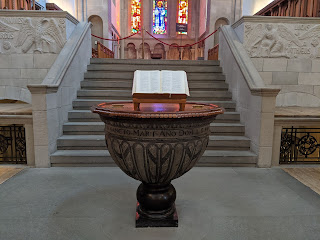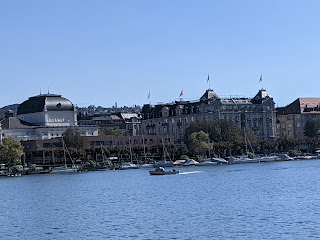On arrival in Zurich the afternoon before from Frankfurt, Steven and I had started to explore the city before calling it a day. Paradeplatz or square was a busy square we ended up passing through several times in our short time in the city as it was a hub for buses and trams and a short hike to the very busy train station. One of Switzerland's largest banks, Credit Suisse, had a large presence on one corner with its street level occupied by high-end shops, although I don't think there was anything but high-end shops in Zurich.
This Daily Travelogue is a labor of love for our families and friends at home and around the world. Prior to 2020, all our trips were documented on separate, yearly blogs which can be accessed below. Remember that clicking on any picture will open it for better viewing. Also, please consider adding your name at the end of any comments. Be safe, stay healthy, and stay connected.
Friday, October 22, 2021
10/1/21: Zurich's Munsters, Platz & Lake
Located on the square was the city's most popular cafe for the last one hundred years, Sprungli that was famous for its Luxemburgli macaroons.
What a fun way to start the day listening to the organ grinder play What a Wonderful World by Louis Armstrong!
A German-only sign said this was Der Klima-Zwingli which meant nothing to me. I googled it and found out Zwingli was a leader in the Swiss Reformation movement during a period of emerging Swiss patriotism. I don't know what that had to be with recycling or concerns with the environment.
Street scenes en route to the next stop on our self-guided walking tour:
As we walked down some steep and narrow stairs, there were glass cases with fragments in them of mosaics with simple black and white limestone designs from when a Roman bath was discovered by accident in 1984.
The Romans had a sophisticated underfloor heating system with a raised floor installed in each room and supported on pillars of clay slabs or sandstone. That created a hollow space beneath the floor which could be heated by a heating duct. Hot flue gas then flowed into the hollow space and from there up through ducts in the walls and finally into chimneys. Darned ingenious, wouldn't you agree considering how ancient it was?!
It was a little spooky treading directly over the ancient excavations but we returned to present-day Zurich in no time when we reached Weinplatz. You may have figured even by its German name that this cute platz of square was a wine square centuries ago
A happy-looking grape picker decorated the adorable fountain in the square.
Zurich's many fountains weren't just for show; we regularly saw locals fill up water bottles with the lovely fresh water.
If we looked really hard, we thought we could spot the Swiss Alps in the distance from where we stood on the Rathausbrucke that spanned the Limmat River. That brucke or bridge was where Zurich's first one was built although how do historians know this, I wonder!
Kay: Ever since Steven and I visited the merry-go-round with you and Gary in your new hometown of Coeur d'Alene last summer, I always think of you when we see them. Here's one in Zurich for you!
Before trying to pop into a police station to gaze at some extraordinary frescoes the day before, Steven and I had only entered one other police station in all our travels. That had been Seville's to report his backpack having been stolen. Yet, here we were admiring, from a distance, thankfully, this fancy neoclassical police station just across the bridge!
I had to wonder if it were a coincidence that the police station had been built directly across from this 17th-century, Renaissance-style Town Hall. I guess miscreants could go directly from town hall to the police station if need be!
The Niederdorf district of Zurich was hailed as a neighborhood of fun shopping, cafes, and nightlife. Considering the exquisite shops we'd viewed on the other side of the Limmat, that must say a lot.
If we'd been even more enthusiastic art lovers, we might have known that the 'anti-art' Dada movement was started in 1916 by a group of rebellious young artists and writers here in Zurich at Cafe Voltaire.
One intriguing store was Schwarzenbach's, a specialty store that has been going strong for over 100 years. It reminded me of shops you see in Old-West movies with almost everything located behind the counter with little in the way of self-service. They must have been doing something right all these years because there were quite a few people waiting to be served.
The previous day Steven and I had spotted from across the river the twin spires of the 12th-century Grossmunster, literally the 'big cathedral' where the Reformation in German-speaking Switzerland took place under the aforementioned Zwingli. After the domes of the Neo-Gothic towers burned down in 1781, they were rebuilt in a plain stone color after lots of discussion.
The simple rounded arches seemed strong and had little ornamentation after the Catholic decor had been stripped in 1519.
I could almost imagine being transported back to an earlier age and listening as fiery orator Zwingli preached from the pulpit.
Unlike some of the Belgian churches whose stained-glass windows had been removed during the Reformation, these choir windows thankfully had not suffered the same fate.
I don't recall seeing a Bible in such a prominent position as this 1531 Zurich Bible was dead center in the church.
Not that I'm a scaredy-cat or anything but I did ask Steven to go down to the crypt with me from the stairs behind the altar.
The crypt wasn't too depressing after all as it only contained an original 15th-century statue of Charlemagne that used to fill a niche outside.
I imagine the same scenario happens with you when you're traveling: you're walking around and notice someone has stopped to take a photo of something that you hadn't noticed before so you decide to follow suit. That happens to us a lot as has the reverse with people stopping to look at what I'm capturing and then taking their own picture. We probably wouldn't have paid any attention to these doors on the back of the church except a couple was peering at them with obvious interest. Well, of course, we were curious to see what sparked their interest!
It was only on closer examination that we saw the handles were so unusual.
We both liked how the panels in the doors told a story, too.
I feel we must have missed some of the 'exciting' Niederdorf area because there was hardly anything on that side of the river that caught our eye as we expected. So, back across the Limmat we trotted on the Munsterbrucke or bridge named after the two Munster, the Grossmunster and Fraumunster, the single-spire church.
The views along the Limmat were quite beautiful from the bridge. Again, I was surprised there was no boat traffic even though we saw plenty of boats tied up along the river.
Looking back at the Grossmunster:
When Zurich was little more than a village in 853, the Fraumunster was founded together with a convent. The current building had occupied the same location since 1250. As a result of Zwingli's Reformation in the mid-1500s, Fraumunster also was gutted.
Before proceeding to the church, we walked around Munsterhof, the large square that had originally been the convent courtyard.
This was as close as we got to the inside of the church made famous for its collection of 30-foot-tall stained-glass windows created by Russian/French artist Marc Chagall when he was over 80. I read that as the windows blended Jewish and Christian traditions, Chagall was able to make people of many faiths feel at home in the church. We would have loved to have seen the windows as well as the rest of the church but it was closed for a funeral. We didn't give up on seeing the church, though, trying two other times to see it, all to no avail, unfortunately.
One of Zurich's many charms were its delightful courtyards visible through narrow doorways. We poked in several as we headed to the waterfront at Zurichsee or Lake Zurich.
Lake Zurich is 17 miles long, 2.5 miles wide, and popular for swimmers in the summer because its relatively shallow depth makes it fairly warm.
Did this sight ever bring a sparkle to Steven's eyes as he had only wanted to visit the Alps!
Seeing a cruise boat return to the dock made us decide to book a cruise for the next day so we could see the rest of the lake. A tourist information official suggested we combine the cruise with a few train excursions on the Swiss national railway to see Rhinefalls, one of the largest waterfalls in Europe. And that's what we did!
A couple more of Zurich's plentiful fountains to finish off the post:
Next post: You know where!
Posted on October 22nd, 2021, from fabulous Florence, an art lover's fantasy.
Labels:
Switzerland
Subscribe to:
Post Comments (Atom)




































































Looks like a gorgeous day in beautiful Zurich-- enjoy Switzerland. xo from Tremblant
ReplyDeleteThanks, Lina, it was a glorious day in Zurich to take in the churches and squares. Hope you're also enjoying a lovely fall day at Tremblant.
ReplyDeleteXoxo